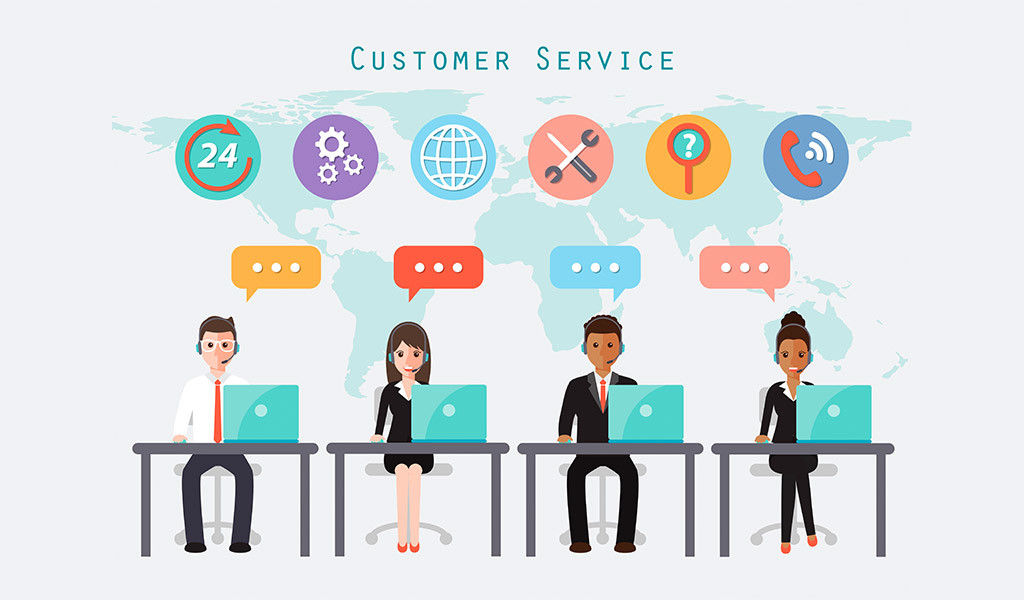
The Appropriate Use Of Technology In Contact Center Operations Can Resolve Even The Biggest Challenges To Contact Center Success
Times are changing in the contact center industry. In stark contrast to the near-total outsourcing and limited functionality of multi-company call centers during the dot-com boom of the early 2000s, two-thirds of contact centers are now located in the Americas, operated as owned or insourced business divisions, and capable of engaging customers through a variety of channels.
There are more than 60,850 contact centers currently active in North America, supporting more than 3.1 million customer service agent (CSA) positions. As a result, both customer service quality and use of contact center technology are largely inconsistent between contact centers even in service of similar industries. What’s more, as businesses recognize the critical role customer service quality (and customer service satisfaction) play in customer retention and profits, the number of contact centers staffed by fewer than 100 CSAs (already 44% of the industry) will continue to grow well into the 2020s. This trajectory toward more in-house contact centers and more small and midsize dedicated contact centers (third-party-owned/operated spaces that contract with just one firm) will further increase the number of distinct contact centers in operation as well as the demand for flexible technology solutions to common contact center industry problems. Keep reading to learn about the biggest challenges facing contact centers in 2020, how the best contact center technology aims to solve these challenges, and which contact center technology you should invest in to stay ahead of the curve (and ahead of your competitors) in 2020.
The Biggest Challenges To Contact Center Success
Contact center success is indicated by the role a center plays in generating revenue for and minimizing costs to its parent company, though the impact of contact center operations can be difficult to link to a company’s bottom line. This is because a firm’s return on investment (ROI) for its contact center technology and operations is a complex measurement. It includes not only the direct costs and savings of recruiting, hiring, training, and implementing technology in contact centers but also the “soft ROI.” That is, firms must consider the financial consequences of intangible contact center “products” — like the approximate 8% above-market revenue growth experienced by firms whose contact center operations make customers feel appreciated.
In the changing landscape of the contact center industry, companies face unique challenges to contact centers’ solvency, the customer service quality and consistency provided therein, and the overall ROI of both insourced and third-party dedicated contact centers. The biggest threats to contact center operations in the coming year are insufficient desktop technology/tools, high levels of CSA turnover, excessively high CSA workloads, poor cross-team collaboration, and poor or unavailable performance and accountability tools. Each of these issues is an active threat (and explicit improvement goal) for more than one in six contact centers, with many centers struggling to overcome multiple challenges at once. Moreover, one in seven contact centers also will acknowledge issues with contact channel integration though fewer than one-quarter have implemented an omnichannel strategy in alignment with current contact center industry best-practices.

The Role Of Technology In Customer Service
Historically speaking, as soon as any innovation in mass communication technology hits the market, businesses try to use it to increase customer service quality. This trend in using technology in contact centers (initially just call centers) began in the early 1950s with the advent of 1-800 numbers. It continued with the incorporation of Interactive Voice Response (IVR) technology in the 1970s, online databases in the 1980s, email in the 1990s, live chat and online helpdesks in the early 2000s, social media in the late 2000s, and now the growth of self service and AI/AR contact center technology through the 2010s. Though the concept of a “contact center” (not a “call center”) is relatively new, each of these technology adoptions moved call centers closer to becoming contact centers. They established a pattern of customer-centric growth and additional multi-channel integration and availability that now defines contact center operations.
Technology In Contact Centers Increases The Potential Customer Service Quality Available
Long wait times, a lack of available human CSAs to take service calls, and CSAs with insufficient product/service and customer-specific knowledge are the top causes of poor customer service quality (and, as a result, low customer satisfaction). Though contact centers’ increased use of technology to mediate customer service interactions is not without its consequences, contact center technology is largely successful in increasing customer satisfaction. This is because (good) contact center technology aims to reduce wait times and increase the accessibility of customer support (and the availability of information to CSAs).
That said, there has been a marked decrease in customer satisfaction with contact center operations over the past five years. This is likely due to the combined effects of customers’ increasingly high expectations for the customer service experiences as well as the inconsistent adoption of high-quality customer service technology in contact centers. As some companies adopt contact center industry-leading tools, customers are coming to expect industry-leading customer service quality from more firms, rendering previously acceptable levels of service comparably unsatisfying.
How Early Adoption Of High-Quality Contact Center Technology Benefits Businesses
The contact center industry is proving to be a space dominated by early adopters when it comes to technology. Modern purchasing decision makers are increasingly fickle (in both B2B and B2C industries) and are both more difficult to retain and easier to lose than ever before. Yet firms that create consistently satisfying customer service experiences more easily maintain long-term customer relationships. This is because 80% of consumers, loyalty is built over time through positive experiences rather than being the result of an absence of negative experiences. Moreover, more than one-third of consumers would not consider themselves loyal to a brand or company until they have made at least five separate purchases from them. As a result, the use of high-quality technology in contact centers dramatically increases customer retention, with firms making appropriate use of high-quality omnichannel customer service platforms (for example) seeing as much as 91% greater year-over-year customer retention rates than firms operating without omnichannel customer support.
At least 89% of businesses compete based on their customer service quality (rather than brand attributes or product pricing), so it is in any business’s best interests to adopt contact center technology that creates consistently satisfying customer service quality. Doing so makes a firm more competitive while simultaneously decreasing the costs of customer acquisition and retention, increasing the average lifetime spend per customer, and maximizing revenues (as increasing customer retention just 5% can boost revenues by as much as 95%).

The Top 7 Trends In Contact Center Technology
1. Advanced Customer Self Service Technology
Providing high-quality customer self-service is already essential to contact center success. By 2020, though, it will be even more important, as fewer than 15% of customer service inquiries will reach a live human CSA and more than two out of five customers will always choose self-service as their first communication channel for customer support. Additionally, contact center industry experts agree that the current trend in consumer attitudes about self-service will continue to grow. That is, consumers will likely become even more resistant to contacting a person about their problem or concern and even more sensitive to insufficient or missing self-service channels. This is significant, considering that more than two-thirds of customers already prefer self-service customer service, and 46% of dissatisfied customers already abandon a purchase rather than engaging a CSA. Therefore 91% of business managers list increasing their firm’s investment in customer self-service as a top priority for the coming year.
2. AI & Machine Learning Tools
Contact center industry experts predict that up to 85% of customer support inquiries will be resolved by AI technology by the end of 2020. This explains why 78% of contact center operations managers have adopted or are planning to adopt AI technology, and 80% have or are planning to adopt the use of chatbot technology by 2020.
Adopting AI technology will not be without challenges. The vast majority of business leaders believe successfully integrating AI technology will boost employee productivity and enable CSAs to focus on high-order issues (at 80% and 72%, respectively). Yet more than three-quarters of those same leaders are concerned about the potential for new AI technology to disrupt day-to-day contact business operations. This suggests that contact center operations managers hoping to get ahead of the trend toward robust AI integration should anticipate facing some significant resistance from risk-focused team members.
3. New Digital Channels
Nearly one-quarter of contact center operations managers consider adding new digital social media channels their top priority for the next twelve months. Prioritizing social media channel management will be essential to contact center success in the coming year, as customer support inquiries through social media have increased more than 250% in the past two years (a trend that shows no signs of slowing).
With as many as 90% of companies aiming to include social media support channels by 2020, companies that forego adopting social media customer support will fall behind the broader contact center industry in terms of both accessibility and response time. This is especially important considering that 90% of consumers use social media to make customer service inquiries (it is the preferred channel of more than one-third), and social media support has the shortest expected wait times (less than 48 seconds for social media live chat and between one and six hours for posts). What’s more, solving customer support inquiries via social media costs one-sixth as much as using traditional channels, and customers assisted via social media channels are 25% more likely to become brand advocates than others.
4. Predictive & Advanced Data Analytics
By 2020 as many as 40% of all data analytics projects will focus on customer service quality. This is because data analytics helps contact center operations managers drive growth, improve efficiency, and increase centers’ ROI. While not a new concept, advanced data analytics (and all the included data points and avenues for data collection) presents firms with new opportunities to leverage data to better understand, serve, and sell to their customers. Predictive analytics, which uses data on past customer behaviors to anticipate future customer decisions, is the newest data analytics tool available. Predictive analytics technology empowers firms to better manage their demand planning, resource optimization (especially human resources), performance assessment, and enriching the customer experience. Data analytics technology in contact centers serves an essential ongoing function no matter what other technology a firm adopts. This explains why the majority of contact center operations managers list advanced analytics technology as a top priority for future development, and 15% specifically list predictive analytics as their number one technology goal for 2020.
5. Intelligent Interactive Voice Response Technology
While Interactive Voice Response technology (IVR) has been around since the 1970s, new advances in speech recognition have made it an increasingly important tool for increasing customer service quality, mainly when used in conjunction with chatbots and AI. Unlike the IVR of old, the use of new IVR technology in contact centers can accommodate customers’ growing fondness for voice-to-search tools, digital CSAs, and automated self-service. The overall impact of following this trend in contact center technology adoption is twofold: first, IVR customer service costs just $1 per customer inquiry, while live chat costs an average of $5 and telephone service costs up to $12. IVR is also an incredibly effective tool for customer journey mapping, as firms can create logic-based procedures in alignment with brand goals. What’s more, customer journey mapping has an ROI of more than ten times the initial investment in mapping technology.
6. Advanced Co-Browsing Software
One of the most consistently useful tools for increasing customer service quality is co-browsing. Specifically, customer service interactions involving co-browsing cause high levels of customer satisfaction among nearly 90% of customers. This is because co-browsing reduces the number of touchpoints a customer must navigate during the customer service experience while simultaneously increasing the chances they will find what they are looking for (a challenge which prompts 46% of potential customers to abandon their purchases).
Moreover, co-browsing dramatically improves customer perceptions about the personalization of their service experience. Personalized (not obviously scripted) attention is one of consumers’ top priorities, along with real-time, entertaining/friendly interactions. What’s more, contact center industry experts predict that, by the end of 2020, three-quarters of consumers will expect real-time, customized, highly personalized service. Advanced co-browsing software meets all of these needs, in addition to increasing conversion by as much as 45%.
7. Customer Recognition Software
Customer recognition is an increasingly critical component of customer service quality. Specifically, 72% of consumers expecting that CSAs will have access to (and use) information about their purchase and service history and nearly half of customers expect specialized treatment in compensation for being a good/loyal customer. It is not surprising, then, that contact center operations managers are increasingly willing to invest in advanced customer recognition software to empower CSAs to meet these expectations.

Sustained Trends In Contact Center Technology Use
Though the above-listed trends represent the leading edge of contact center technology, there is one more type/use of technology in contact centers that is critical to contact center success. Though not a new trend, omnichannel customer service platforms are a persistent technology that has built significant momentum in the contact center industry (especially during the last five years).
Omnichannel Customer Service Platform Technology In Contact Centers
Omnichannel platforms are one of the best tools to improve contact center operations. This is because nine out of ten customers prefer omnichannel service, and customers engaged via omnichannel technology spend 4% more in-store and 10% more online than single-channel shoppers. Moreover, the positive impacts of omnichannel technology in contact centers are so well understood that more than one-third of firms plan to do so by 2020.
That said, the customer service quality created by different omnichannel platforms varies significantly. Firms that use strong omnichannel platforms retain as many as 89% of customers, while firms that use weak omnichannel technology retain just 33%. This variance in retention rates (and implied variance in customer satisfaction) is due to the conflation of “omnichannel” services and “every channel” services. That is, many firms invest in contact center technology that increases the availability of customer support staff across different communication channels without actually creating a true omnichannel strategy.
The defining characteristic of omnichannel technology is that it empowers CSAs to provide a seamless experience, rather than just creating many points of contact. Yet only 85% of omnichannel platforms include CSA training technology and 77% store and make customer data easily accessible across multiple channels. Not all omnichannel technology provides an authentic omnichannel experience. Consequently, more than seven out of ten firms that say they use omnichannel contact center technology are not successful in their attempts to do so (based on discrepancies between survey responses given by contact center operations managers vs. customers).
Adopting a strong omnichannel platform can take the guesswork out of creating an effective omnichannel customer support strategy. What’s more, if you choose a robust omnichannel platform (like CommBox), the tools included as part of the larger software package may supplant the need for additional technologies, lowering adoption and training costs and making synchronized use of different tools much easier.